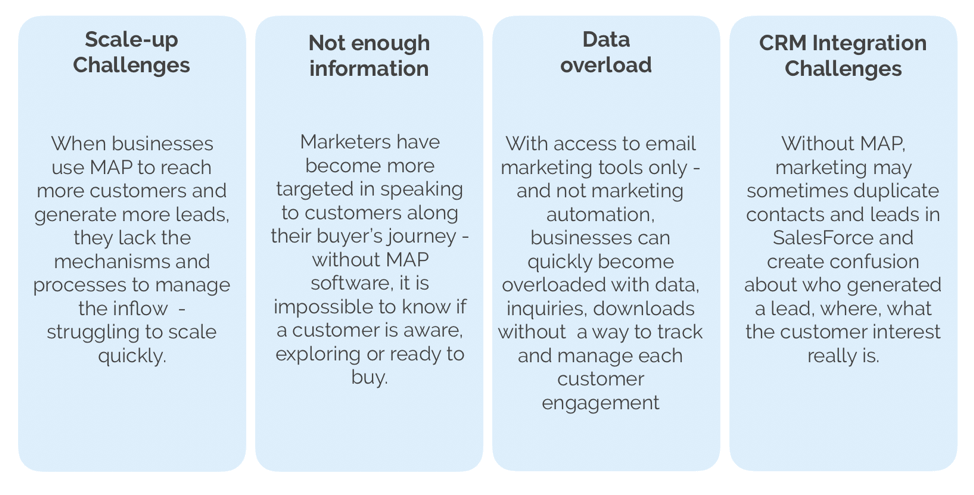Home > Insights > Sales & Marketing > What is Marketing Automation?
What is Marketing Automation?
By: Kiran Chin
May, 2020
Marketing automation is critical to achieving business success in today’s digital universe. Marketing automation offers a comparative advantage to reaching customers, generating brand awareness and building pipeline.
Marketing Automation Platforms (MAP) offer high automation with a low total cost of ownership, making marketing automation one of the fastest growing markets in enterprise software. Marketing automation software varies among vendors – however the typical features of MAP software includes lead generation. lead nurturing, lead scoring and management and analytics.
Not to be confused with Email Marketing (ie. Mailchimp or Constant Contact) who simply offer email sending capabilities, which are a normal part of lead nurturing.
Not to be confused with Email Marketing (ie. Mailchimp or Constant Contact) who simply offer email sending capabilities, which are a normal part of lead nurturing.
Financial Benefits of Marketing Automation
- 10% increase in revenues (IDC)
- Drive 9% more sales quota achievement rates (Oracle)
- Generate 50% more sales-ready leads at 33% lower cost (Oracle)
- Targeted & relevant emails deliver 18X revenue than “batch-and-blast” (Oracle)
- Experience 451% increase in qualified leads (Oracle)
In today’s digital universe, MAP software helps address several new and evolving marketing challenges.

Perhaps more difficult to quantify are the intangible or soft benefits of MAP software, which provides businesses with the ability to selectively target customers where they are on the Buyer’s Journey with the right messaging at the right time in their buying process to help progress them along the sales process.
Other operational benefits of MAP software are listed below.
Operational Benefits of Marketing Automation
- Build a more effective revenue engine
- Optimize marketing spend faster
- Profile customer information and behavior to selectively target buyers
- Measure and manage effectiveness of marketing programs
- Reliably predict revenue outcomes of marketing and sales efforts
- Improve campaign performance
- Better lead handling/management (remove duplications & confusion)
What is Marketing Automation?
LEAD GENERATION
The process of creating leads through email marketing campaigns or landing pages.
LEAD NURTURING
Identifying where a lead is in the buyer’s journey and helping them progress towards making a purchasing decision
LEAD MANAGEMENT
Scoring leads based on behavior and demographics and routing them to the next step in a firm’s marketing automation strategy
ANALYTICS / TRACKING
Track and analyze critical KPIs i.e. click-through, conversions and website traffic.
Lead Generation
Demand Generation or Lead Generation is the start of many marketing automation platforms – capturing customer contact and creating a ‘lead’. Leads are often generated via several marketing tactics such as email marketing or campaigns driving towards landing pages. However the critical capture of information for a lead is done via a ‘form’ – a critical input step in lead gen.
Refine, target, optimize program initiatives with the ability to manage, report and automate the moving parts of a campaign. This software provides visibility to executives on the activities of marketing – full transparency on what is being worked on, how many leads in the system, returns of certain efforts/campaigns.
Note: Leads can be augmented by third-party providers who can add missing fields such as email or demographic data, org charts and titles.
Refine, target, optimize program initiatives with the ability to manage, report and automate the moving parts of a campaign. This software provides visibility to executives on the activities of marketing – full transparency on what is being worked on, how many leads in the system, returns of certain efforts/campaigns.
Note: Leads can be augmented by third-party providers who can add missing fields such as email or demographic data, org charts and titles.
Lead Nurturing
According to Marketo and MarketingSherpa, 79% of leads never convert to sales due to a lack of nurturing. However, companies that excel at lead nurturing generate 50% more sales ready leads and cost 33% less.
In today’s digital era, lead nurturing is synonymous with building a relationship with a customer. Understanding where that customer is in his/her buyer’s journey. Recommending items based on his/her preference. The nurturing process allows businesses to be more targeted with prospective buyers. If campaigns are irrelevant to customers – they will quickly unsubscribe (the loss of a lead, reduction of database and a lost prospective customer and revenue).
Lead nurturing helps address fear and uncertainty when dealing with lesser-known brands – and helps establish trust and credibility. This often occurs through sharing useful information, establishing thought-leadership and providing customer testimonials.
In today’s digital era, lead nurturing is synonymous with building a relationship with a customer. Understanding where that customer is in his/her buyer’s journey. Recommending items based on his/her preference. The nurturing process allows businesses to be more targeted with prospective buyers. If campaigns are irrelevant to customers – they will quickly unsubscribe (the loss of a lead, reduction of database and a lost prospective customer and revenue).
Lead nurturing helps address fear and uncertainty when dealing with lesser-known brands – and helps establish trust and credibility. This often occurs through sharing useful information, establishing thought-leadership and providing customer testimonials.
Lead Management
How a lead comes into the organization, how it is routed, scored and handled is a critical part of marketing automation. Triggers and scoring are determined by the organization and moves leads to where they need to be to keep the discussions moving.
Lead scoring requires alignment between sales and marketing on where a customer is in his/her buyer’s journey and uses BANT (budget, authority, need, timeline) as well as qualification data (activity, behavior, lead response) relative to product type, customer segment, estimated customer value and opportunity value.
Lead scoring requires alignment between sales and marketing on where a customer is in his/her buyer’s journey and uses BANT (budget, authority, need, timeline) as well as qualification data (activity, behavior, lead response) relative to product type, customer segment, estimated customer value and opportunity value.
Analytics / Performance Marketing
To benchmark performance of an organization’s marketing automation strategy, it is important to identify metrics of success. Examples of some metrics include:
- Open Rate: % of emails opened
- Clickthrough Rate (CTR): % of users that click through an email
- Soft Bounce: Bounce back from server (unopened)
- Hard Bounce: Permanent error delivery (incorrect emails)
- Abuse: Reporting Abuse
- Unsubscribe: Loss of a Contact
- Click to Open Rate (CTOR): Unique clicks divided by unique opens (of the recipients who opened the emails, how many clicked through)
- Conversion: Clicks on specific call to action (“Contact Us”, “Register”)
- Website traffic: How many unique or returning users to the site
- List growth: Increase in the # of contacts
Insight
In today’s digital economy, where there is more access to customers than ever before. A heightened ability to engage directly with customers on a one-on-one, there is a demand for better marketing and sales tools that rely on technology to automate the conversations and track along with the change in buying behavior.
Marketing automation is a must-have for every organization to be able to compete. Not having a marketing automation strategy is a severe disadvantage to businesses – especially those with limited sales and marketing staff.
Marketing automation is a must-have for every organization to be able to compete. Not having a marketing automation strategy is a severe disadvantage to businesses – especially those with limited sales and marketing staff.



